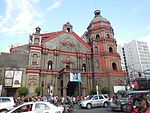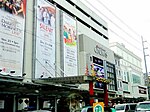Binondo

Binondo (Chinese: 岷倫洛; pinyin: Mínlúnluò; Pe̍h-ōe-jī: Bîn-lûn-lo̍h) is a district in Manila and is referred to as the city's Chinatown. Its influence extends beyond to the places of Quiapo, Santa Cruz, San Nicolas and Tondo. It is the oldest Chinatown in the world, established in 1594 by the Spaniards as a settlement near Intramuros but across the Pasig River for Catholic Chinese, it was positioned so that colonial rulers could keep a close eye on their migrant subjects. It was already a hub of Chinese commerce even before the Spanish colonial period. Binondo is the center of commerce and trade of Manila, where all types of business run by Filipino-Chinese thrive. Noted residents include Saint Lorenzo Ruiz, the Filipino protomartyr, and Venerable Mother Ignacia del Espiritu Santo, founder of the Congregation of the Religious of the Virgin Mary.
Excerpt from the Wikipedia article Binondo (License: CC BY-SA 3.0, Authors, Images).Binondo
Sevilla Street, Manila San Nicolas (Third District)
Geographical coordinates (GPS) Address Nearby Places Show on map
Geographical coordinates (GPS)
| Latitude | Longitude |
|---|---|
| N 14.6 ° | E 120.967 ° |
Address
Sevilla Street
Sevilla Street
1010 Manila, San Nicolas (Third District)
Philippines
Open on Google Maps







